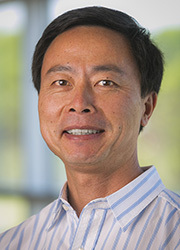Expert: Editing stem cell genes will “revolutionize” biomedical research
Applying a dramatically improved method for “editing” genes to human stem cells, University of Wisconsin–Madison professor of neuroscience Su-Chun Zhang has shown a new way to silence genes in stem cells and their progeny at any stage of development.
The advance has advantages in speed and efficiency, says Zhang, and is already being used for basic biological studies.

Su-Chun Zhang
The invention of gene “knock-outs” earned the 2007 Nobel Prize for its utility in determining what genes do. Oliver Smithies, one of three recipients, performed the winning research at UW–Madison.
The new discovery solves two limitations with existing knock-out techniques. Shutting off a gene too soon can kill a cell or stymie development. And the knock-out techniques did not work well with human embryonic and induced pluripotent stem cells, the do-it-all cells that can transform into any cell in the body.
Now, after 10 years of effort, Zhang, of the Waisman Center, has revealed how to shut off genes in embryonic stem cells after they have been functioning normally. His work is published in the July 2 edition of Cell Stem Cell.
“Timing is the critical advance,” says Zhang, who was the first to shape embryonic stem cells into neurons. “Silencing a gene later in development can tell us what it may do in the adult human which we cannot research on. This means you can take out the gene at any given time, in any type of cell.”
If you delete a gene too soon, the stem cell may not survive, he points out. “You may want to delete it after the cells have differentiated into heart, brain or liver cells. You could get even more exact: Say you want to wait until a neural progenitor cell has matured. That precision is one reason I see so much promise in this technology.”
A second benefit resides in the simplicity and efficiency of the technique, called CRISPR, that Zhang used to set up the knockout. With CRISPR, researchers implant brackets at each end of the gene segment they want to remove, then activate the brackets with an enzyme that removes the segment from both strands and rejoins the chain.
The previous technology, called homologous recombination, can only remove one side of the two-stranded DNA that composes a gene, leaving one strand that is still functional. To produce a knock-out mouse, researchers must cross-breed animals after one strand of the gene is gone, then search for one mouse with two broken strands.
That takes a lot of work, and since cells cannot mate, the technique fails for stem cells. Alternative techniques were so tedious and inefficient “that it is not worthwhile doing the work,” Zhang says.
While the traditional homologous recombination gene editing can only transform a tiny fraction of human cells, CRISPR works in about 50 percent of stem cells, Zhang says. Adding the second step used to control when the silencing occurs cuts the efficiency to about 25 percent, still better than before.
The on-demand deletion system that Zhang has pioneered depends on a fifth column — an insurgent that hides until it is directed to attack. The fifth column is an implanted bit of genetic code that sits idle until a certain drug enters the cell. Then the code creates an enzyme that cuts the bracketed gene and reconnects the DNA chain.
To show what the technology can do, Zhang and post-doctoral researcher Yuejun Chen attached brackets to a gene known to separate the midbrain from the forebrain, the site of higher mental functions. Using the delayed knock-out function, they found that the gene is also essential to forming the forebrain. “If you knock it out, you simply don’t have the cerebral cortical cells, and they are essential to what it takes to be human,” Zhang says. “This is a really definitive way to show what genes are doing.”
Clinical use is further away, but Zhang is thinking about knocking out over-active genes to prevent or to treat disease. Genes that regulate cell division, for example, are often over-active in cancer; gene editing could silence these genes to stop a cancer. Clinicians worry that transplanting stem cells to heal diabetes or Parkinson’s disease raises the risk of endless cell divisions and cancer. Removing genes that promote cell division could forestall that danger.
Long before those uses reach the clinic, however, gene editing will be used to probe the role of genes, Zhang says. “We engineer one cell, and then we expand a large number of cells, and all the offspring have the same engineered ability to delete on demand. You can very quickly pin down exactly what this gene does, at the stem cell stage, neural stem cell stage or at the differentiated neuron stage.”
The research was funded by the National Institutes of Health, the Bleser Family Foundation and the Busta Foundation.
To take advantage of the discovery, UW–Madison has opened a genome editing facility in its Biotechnology Center. “We want the whole campus to utilize this technology, for human biology and the model organisms that are so important for biology, like fruit flies and zebra fish,” Zhang says.
Other scientists have filed patents on some key steps used in the new advance, but Zhang has decided not to file a patent on his contributions. “We’ll distribute cells through the WiCell Research Institute,” a Wisconsin non-profit that distributes stem cells to researchers. “The goal is to build these common cell lines and let everybody use them. People don’t need to reinvent the wheel.”
“I really want people to use these cells,” Zhang says. “My lab has only so many people. This marriage between human stem cells and genome editing technology will revolutionize the way we do science. It completely opens the field in front of us.”
Tags: research, stem cells, Waisman Center




